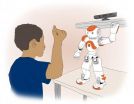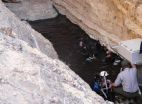(Press-News.org) China's rapid emergence as a global power has coincided with a series of unprecedented challenges to Chinese people's health. The fifth China themed issue of The Lancet provides a picture of the complex health issues facing China, and looks at how better health outcomes for Chinese people can be achieved into the future.
In this issue, the journal highlights the dire consequences that urbanisation and increasing affluence are having on China's chronic disease burden. The journal also reports systematic and comprehensive assessments of China's health-care system and revamping the world's largest medical education system.
Important advances have been made in expanding health insurance coverage to 96% of the population in China. However, these increases have not been accompanied by improvements in the "wasteful and inefficient" health-care delivery system, whilst poor working conditions including underpaid and overworked doctors are fuelling an escalating crisis of violent attacks against medical workers. The Series looks at how China has moved closer to its goal of affordable, quality basic health care for all, and reviews the challenges that still lie ahead and adjustments needed for successful reform.
China has increasingly emerged as an important player in global health and the Series concludes by looking at China's global health strategy. In particular, how China is reshaping the global health landscape with its distinctive approach to foreign aid, and in global health policy-making via its active participation in important international organisations such as WHO, UNAIDS, and the Global Fund.
China must act now to tackle timebomb of chronic diseases, warn experts
"Wasteful and inefficient" health-care delivery could derail China's ambition to achieve affordable and quality basic health care for all
Revamping the world's largest medical education system: mixed results of progress
China: reshaping the global health landscape
The Lancet: China must act now to tackle timebomb of chronic diseases, warn experts
China must act now to tackle the growing challenges posed by injuries, mental illness, obesity, smoking, environmental pollution and other public health threats or face the huge toll of largely preventable health loss suffered by high-income countries, warn experts in a Review published as part of a Lancet themed issue on China.
Rapid and extraordinary economic growth over the past few decades has resulted in some shocking statistics on death and illness from injuries and chronic diseases in China. Injuries cause around 800 000 deaths a year and are the leading cause of death in people aged 1 to 39 years old. Some 173 million adults have a mental health disorder but the vast majority (92%; 159 million) have never received professional help. The number of people living with dementia has more than doubled from about 3.68 million in 1990 to 9.2 million in 2010. Ambient air pollution kills more than 1.2 million people a year, while indoor air pollution from solid fuels accounts for a further 1 million premature deaths a year. Tobacco kills roughly 1 million people each year, and if present trends continue, this is expected to rise to 3 million by 2040. Finally, there have been alarming increases in levels of obesity, with the number of overweight or obese adolescents rising from 16.1 million in 2000 to 20.4 million in 2010.
In this Review, Dr Jeffrey Koplan, Vice President for Global Health at Emory University, Atlanta, USA and colleagues take a critical look at progress in tackling chronic diseases since the 1990s, lament the inadequate coverage of basic interventions that could make a massive difference, and urge China to urgently adopt a number of cost-effective interventions to improve individual and population health (eg, increasing taxes on tobacco and alcohol and introducing regulations for seat belts and helmets for cyclists).
According to Professor Koplan, "Similar to the focus on prevention, which was the hallmark of China's remarkable success against infectious diseases, its new challenge will be to make this progress in chronic disease control in a much shorter time-frame than high-income countries. If China takes advantage of lessons learnt in other countries (including taxation, regulation or legislation, and information or education) and uses its own scientific and creative resources to increase our knowledge of better disease control and prevention, it will provide a health model for the world."*
Notes to Editors:
*Quote direct from authors and cannot be found in text of Review.
The Lancet: "Wasteful and inefficient" health-care delivery could derail China's ambition to achieve affordable and quality basic health care for all
China has done well in expanding the coverage of health insurance to 96% of the population since it launched nationwide health-care reforms in 2009, but poorly in reforming the "wasteful and inefficient" health-care delivery system. These substantial challenges, together with a new policy to promote private hospitals is endangering China's goal of providing affordable and quality basic health care to all by 2020, according a Review published as part of a Lancet themed issue on China.
"Chinese health care still faces considerable challenges to transform from a poorly governed, hospital-centred system that puts profit above patient welfare, to a primary care-based delivery system that is cost effective and better able to respond to a population increasingly affected by chronic diseases and disabilities associated with ageing", explain authors Winnie Yip, Professor of Health Policy and Economics at the Blavatnik School of Government, University of Oxford, UK, and William Hsiao, research Professor of Economics at Harvard School of Public Health, Boston, USA.*
Despite the government almost doubling annual health spending to ¥836.6 billion (£1 is roughly equal to ¥10) between 2009 and 2012, with substantial investment in primary health care, most visits and admissions continue to take place in hospitals. As a result, primary health-care facilities have not been able to perform their key functions of prevention, case-detection, gate-keeping, and referral—essential for chronic disease prevention and control.
Take hypertension (high blood pressure) as an example. Despite being the second largest risk factor causing disability and death (the first being tobacco), only 42%% of adults with hypertension are aware they have the condition, whilst just a third to half of patients with hypertension receive treatment. What is more, admission rates for complications from diabetes in China are more than five times the rate in countries of the Organization for Economic Cooperation and Development (OECD) countries—a sign of poor primary health care.
Worryingly, say the authors this might only be the tip of the iceberg: "The government's latest strategy to promote private investment for hospitals, with the target of private hospitals meeting a 20% market share by 2015, would result in escalating health-care expenditure, with patients bearing increasing costs; a two-tiered system in which access and quality of care are decided by ability to pay; and poor population health outcomes."*
They conclude that to steer China back on course to achieve its health goals an alternative strategy is needed to reform public hospitals to pursue the public interest and be more publically accountable, with public hospitals as the benchmarks against which private hospitals would have to compete. They add, "China should assess how the entry of private hospitals affects its health-care system before it makes any decision to further expand their market share. Otherwise, China might not be able to rein in a runaway delivery system plagued with inequity and cost escalation."
Notes to Editors:
*Quotes direct from authors and cannot be found in text of Article.
The Lancet: Revamping the world's largest medical education system: mixed results of progress
Beginning in 1998, China launched sweeping reforms to the higher education system in which medical education was also substantively promoted to ensure that health professionals were trained more effectively and efficiently to produce a workforce of sufficient size, specialty mix, and skill to meet public needs. A Review in The Lancet themed issue on China reports mixed results of progress and highlights the urgent need for further reform.
The reform was urgently needed, explained Professor Yang Ke, author and Executive Vice President of Peking University Health Science Center, Beijing, China. "Before the reform, China had more doctors than nurses, and many nurses had only been educated to high school or secondary school level. Doctor density in urban areas was more than twice that in rural areas. And despite efforts to train very large numbers of medical graduates, many did not enter the health workforce and took jobs in industry or changed occupations, highlighting inefficiencies in the system."*
The ambitious education reforms have successfully merged training institutions into universities and greatly increased the enrolment of health professions. In 2012, China produced 500 000 health professional graduates from 590 institutions, including 29 000 nurses with bachelor degrees and 156 000 with diplomas to help correct the very low nurse-to-doctor ratios. Furthermore, new policies offering incentives for doctors to work in rural areas were launched in 2010, and more recently, a target to train 300 000 general practitioners (GPs) by 2020 was announced.
There is more to be done, say the authors. "Some educational reforms appear to be on the mark—more nurses, GPs, and rural doctors, but other needed reforms have yet to begin. Infrastructure, public funding, and faculty size have not kept pace with rapid student expansion, raising concerns about the impact on academic quality. Worryingly, since 1998 there have been insufficient curriculum changes. Biomedical sciences and clinical practice continue to dominate the curriculum to the detriment of content that would enhance patient care (eg, humanities, social sciences, communication skills, ethics, public health, and patient exposure)."*
Worse still, they say, "Poor health-care system conditions including underpaid and overworked doctors with only brief time for patients; poor communications between doctors and patients; and a lack of patient trust in profit-driven doctors ordering of tests and drugs, are fuelling an escalating crisis of violent attacks against medical workers and medical disputes. Medical disputes have increased by about 23% every year since 2002, and medical violence has tripled in 8 years, from around 5000 incidents in 2002, to over 17 200 in 2010."*
Notes to Editors:
*Quotes direct from authors and cannot be found in text of Review
The Lancet: China: reshaping the global health landscape
In this paper, published as part of a Lancet themed issue on China, Professor Peilong Liu from Peking University Health Science Center, Beijing, China and colleagues discuss China's distinctive approach to, and increasing participation in, global health.
Taking foreign aid as an example, they show that the type of health aid China offers is different from other developed countries, driven by its unique history and competencies, and complex motivational factors—political, economic, social, and humanitarian. Rather than offering general financial support, China focuses on some important aspects of the health system such as deploying medical teams, constructing hospitals and clinics, donating drugs and medical equipment, training personnel, and supporting malaria control efforts using artemisinin based on traditional Chinese medicine.
Over the past 50 years, China has dispatched around 23 000 medical personnel to about 66 countries providing services for an estimated 270 million people and constructed more than a hundred health facilities mainly in Africa and Asia. Recently, China has also been an active member in the UN and other related bodies such as WHO, and has become a contributor to multilateral funding pools such as the Global Fund.
The Review concludes that, "the scope and depth of China's global engagement are likely to grow and reshape the contours of global health."
INFORMATION:
The Lancet: China-themed issue
2014-08-29
ELSE PRESS RELEASES FROM THIS DATE:
Study finds shortcomings in doctor-patient discussions about transplantation
2014-08-29
Highlights
When dialysis patients reported discussions about transplantation with clinicians, they had a nearly 3-fold increased likelihood of being listed for transplantation, but clinician-reported discussions did not increase a patient's likelihood of being listed.
In almost one-third of cases, clinicians reported that they had discussed transplantation with a particular dialysis patient, but the patient said that nobody had discussed it with them.
Washington, DC (August 28, 2014) — In a study of dialysis patients, those who reported that they had discussed ...
Complications of tube insertion in ears not worse for kids with cleft lip/palate
2014-08-28
Bottom Line: Children with cleft lip and/or palate (CLP) have no worse complications from ventilation tube (VT) insertion in their ears to treat otitis media with effusion (OME, a buildup of fluid in the ear) or acute otitis media (AOM, a common ear infection), two conditions which can result in hearing loss.
Author: Ian Smillie, M.R.C.S. Ed., of the Royal Hospital for Sick Children, Glasgow, Scotland, and colleagues.
Background: CLP is a common birth defect in children, occurring in 1 of 700 births. Optimizing hearing in children with CLP is important to avoid problems ...
Socially-assistive robots help kids with autism learn by providing personalized prompts
2014-08-28
LOS ANGELES - August 28, 2014: This week, a team of researchers from the USC Viterbi School of Engineering will share results from a pilot study on the effects of using humanoid robots to help children with autism practice imitation behavior in order to encourage their autonomy. Findings from the study, entitled "Graded Cueing Feedback in Robot-Mediated Imitation Practice for Children with Autism Spectrum Disorders," will be presented at the 23rd IEEE International Symposium on Robot and Human Interactive Communication (RO-MAN) conference in Edinburgh, Scotland, on Aug. ...
Flapping baby birds give clues to origin of flight
2014-08-28
How did the earliest birds take wing? Did they fall from trees and learn to flap their forelimbs to avoid crashing? Or did they run along the ground and pump their "arms" to get aloft?
The answer is buried 150 million years in the past, but a new University of California, Berkeley, study provides a new piece of evidence – birds have an innate ability to maneuver in midair, a talent that could have helped their ancestors learn to fly rather than fall from a perch.
The study looked at how baby birds, in this case chukar partridges, pheasant-like game birds from Eurasia, ...
Prions can trigger 'stuck' wine fermentations, researchers find
2014-08-28
A chronic problem in winemaking is "stuck fermentation," when yeast that should be busily converting grape sugar into alcohol and carbon dioxide prematurely shuts down, leaving the remaining sugar to instead be consumed by bacteria that can spoil the wine.
A team of researchers including UC Davis yeast geneticist Linda Bisson has discovered a biochemical communication system behind this problem. Working through a prion -- an abnormally shaped protein that can reproduce itself -- the system enables bacteria in fermenting wine to switch yeast from sugar to other food sources ...
Researchers use NASA and other data to look into the heart of a solar storm
2014-08-28
A space weather storm from the sun engulfed our planet on Jan. 21, 2005. The event got its start on Jan. 20, when a cloud of solar material, a coronal mass ejection or CME, burst off the sun and headed toward Earth. When it arrived at our planet, the ring current and radiation belts surrounding Earth swelled with extra particles, while the aurora persisted for six hours. Both of these are usually signs of a very large storm – indeed, this was one of the largest outpouring of solar protons ever monitored from the sun. But the storm barely affected the magnetic fields around ...
After Great Recession, Americans are unhappy, worried, pessimistic, Rutgers study finds
2014-08-28
NEW BRUNSWICK, N.J. – The protracted and uneven recovery from the Great Recession has led most Americans to conclude that the U.S. economy has undergone a permanent change for the worse, according to a new national study at Rutgers. Seven in 10 now say the recession's impact is permanent, up from half in 2009 when the recession officially ended, according to the John J. Heldrich Center for Workforce Development.
Among key findings in "Unhappy, Worried and Pessimistic: Americans in the Aftermath of the Great Recession," the center's latest Work Trends report, are:
Despite ...
A VA exit strategy
2014-08-28
LEBANON, NH – As the federal government plans its exit strategy from the war, now may be the time for it to rethink its role in providing health care to veterans, says a Perspective piece in the New England Journal of Medicine.
"To simply go on doing more of the same is to fail to recognize the challenge that the Veterans Health Administration's cost and population structure pose in the longer run," said William Weeks, from The Dartmouth Institute for Health Policy & Clinical Practice, and David Auerbach, from the RAND Corporation, in the August issue of NEJM.
The ...
The universal 'anger face'
2014-08-28
The next time you get really mad, take a look in the mirror. See the lowered brow, the thinned lips and the flared nostrils? That's what social scientists call the "anger face," and it appears to be part of our basic biology as humans.
Now, researchers at UC Santa Barbara and at Griffith University in Australia have identified the functional advantages that caused the specific appearance of the anger face to evolve. Their findings appear in the current online edition of the journal Evolution and Human Behavior.
"The expression is cross-culturally universal, and even ...
Climate change puts endangered Devils Hole pupfish at risk of extinction
2014-08-28
RENO, Nev. – Climate change is hurting reproduction of the endangered Devils Hole pupfish, threatening the survival of this rare species that has numbered as few as 35 individuals, new research by the University of Nevada, Reno and Desert Research Institute shows.
Scientists report that geothermal water on a small shelf near the surface of an isolated cavern in the Nevada desert where the pupfish live is heating up as a result of climate change and is likely to continue heating to dangerous levels.
The hotter water, which now reaches more than 93 degrees, has shortened ...




